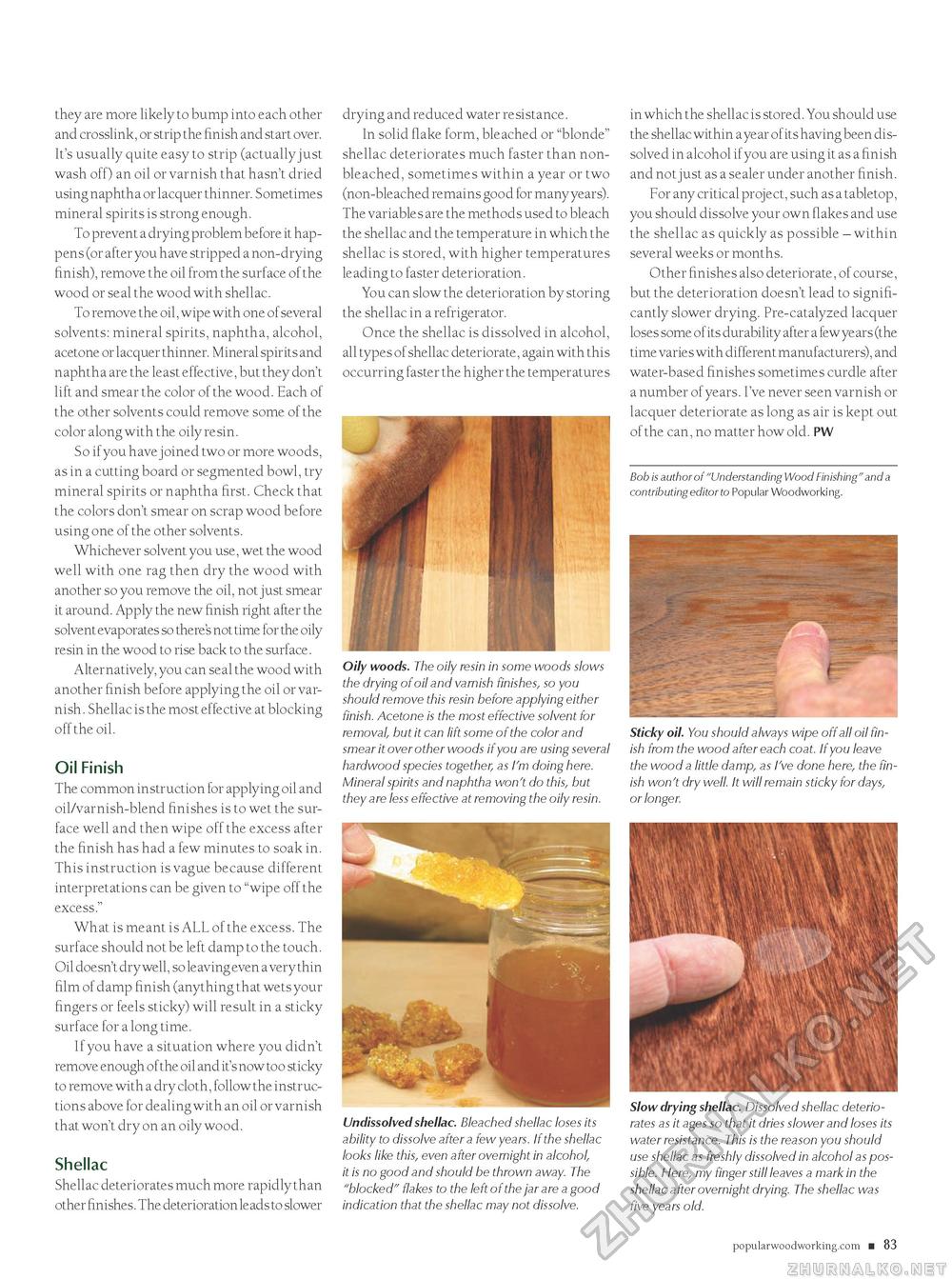Popular Woodworking 2008-04 № 168, страница 93
they are more likely to bump into each other and crosslink, or strip the finish and start over. It's usually quite easy to strip (actually just wash off) an oil or varnish that hasn't dried using naphtha or lacquer thinner. Sometimes mineral spirits is strong enough. To prevent a drying problem before it happens (or after you have stripped a non-drying finish), remove the oil from the surface of the wood or seal the wood with shellac. To remove the oil, wipe with one of several solvents: mineral spirits, naphtha, alcohol, acetone or lacquer thinner. Mineral spirits and naphtha are the least effective, but they don't lift and smear the color of the wood. Each of the other solvents could remove some of the color along with the oily resin. So if you have joined two or more woods, as in a cutting board or segmented bowl, try mineral spirits or naphtha first. Check that the colors don't smear on scrap wood before using one of the other solvents. Whichever solvent you use, wet the wood well with one rag then dry the wood with another so you remove the oil, not just smear it around. Apply the new finish right after the solvent evaporates so there's not time for the oily resin in the wood to rise back to the surface. Alternatively, you can seal the wood with another finish before applying the oil or varnish . Shellac is the most effective at blocking off the oil. Oil Finish The common instruction for applying oil and oil/varnish-blend finishes is to wet the surface well and then wipe off the excess after the finish has had a few minutes to soak in. This instruction is vague because different interpretations can be given to "wipe off the excess." What is meant is ALL of the excess. The surface should not be left damp to the touch. Oil doesn't dry well, so leaving even a very thin film of damp finish (anything that wets your fingers or feels sticky) will result in a sticky surface for a long time. If you have a situation where you didn't remove enough of the oil and it's now too sticky to remove with a dry cloth, follow the instructions above for dealing with an oil or varnish that won't dry on an oily wood. Shellac Shellac deteriorates much more rapidly than other finishes. The deterioration le ads to slower drying and reduced water resistance. In solid flake form, bleached or "blonde" shellac deteriorates much faster than non-bleached, sometimes within a year or two (non-bleached remains good for many years). The variables are the methods used to bleach the shellac and the temperature in which the shellac is stored, with higher temperatures leading to faster deterioration. You can slow the deterioration by storing the shellac in a refrigerator. Once the shellac is dissolved in alcohol, all types of shellac deteriorate, again with this occurring faster the higher the temperatures Oily woods. The oily resin in some woods slows the drying of oil and varnish finishes, so you should remove this resin before applying either finish. Acetone is the most effective solvent for removal, but it can lift some of the color and smear it over other woods if you are using several hardwood species together, as I'm doing here. Mineral spirits and naphtha won't do this, but they are less effective at removing the oily resin. Undissolved shellac. Bleached shellac loses its ability to dissolve after a few years. If the shellac looks like this, even after overnight in alcohol, it is no good and should be thrown away. The "blocked" flakes to the left of the jar are a good indication that the shellac may not dissolve. in which the shellac is stored. You should use the shellac within a year of its having been dissolved in alcohol if you are using it as a finish and not just as a sealer under another finish. For any critical project, such as a tabletop, you should dissolve your own flakes and use the shellac as quickly as possible - within several weeks or months. Other finishes also deteriorate, of course, but the deterioration doesn't lead to significantly slower drying. Pre-catalyzed lacquer loses some of its durability after a few years (the time varies with different manufacturers), and water-based finishes sometimes curdle after a number of years. I've never seen varnish or lacquer deteriorate as long as air is kept out of the can, no matter how old. PW Bob is author of "Understanding Wood Finishing" and a contributing editor to Popular Woodworking. Sticky oil. You should always wipe off all oil finish from the wood after each coat. If you leave the wood a little damp, as I've done here, the finish won't dry well. It will remain sticky for days, or longer. Slow drying shellac. Dissolved shellac deteriorates as it ages so that it dries slower and loses its water resistance. This is the reason you should use shellac as freshly dissolved in alcohol as possible. Here, my finger still leaves a mark in the shellac after overnight drying. The shellac was five years old. popularwoodworking.com ■ 83 CIRCLE #100 ON FREE INFORMATION CARD. |








